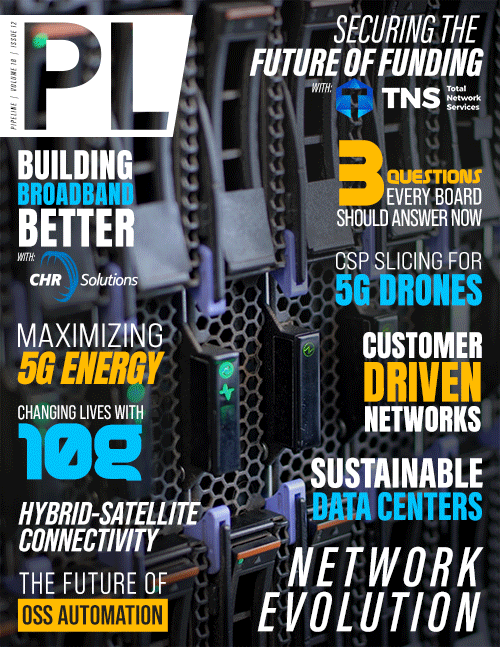Data Centers Promise Big Steps
Toward Smaller Carbon Footprint
By: Craig McKesson
 If I asked ten people what “technological evolution” means, I would undoubtedly get ten different answers. Our currently evolving technology infrastructure is a dynamic process that is
simultaneously both a theory and a practice. Elements of this evolution run the gamut from the physical to the virtual, and at every touchpoint in between. Evolution, by its definition, is not a
siloed concept, but rather one that requires comprehensive and integrative strategies that incorporate both current technological advancements and those that we know are coming in the
not-so-distant future.
If I asked ten people what “technological evolution” means, I would undoubtedly get ten different answers. Our currently evolving technology infrastructure is a dynamic process that is
simultaneously both a theory and a practice. Elements of this evolution run the gamut from the physical to the virtual, and at every touchpoint in between. Evolution, by its definition, is not a
siloed concept, but rather one that requires comprehensive and integrative strategies that incorporate both current technological advancements and those that we know are coming in the
not-so-distant future.
Beyond the bespoke components of our technology evolution that routinely grab headlines—such as 5G wireless, autonomous vehicles, AI/VR, quantum computing hardware, predictive software, and advances in “smart” technology—increasing social responsibility factors are also evolving exponentially in tandem. In the physical center of all of this are the data centers that provide the vital digital infrastructure that constructs, houses, enables, safeguards, and supports massive amounts of data and connectivity. In 2021, digital infrastructure included seven million data centers worldwide equating to 2.4 percent of global energy consumption. With ever-increasing technological growth and demand, there is an urgency for the data center and digital infrastructure communities to come together and evolve as an environmentally and socially responsible industry.
The conversation around environmental, social, and governance (ESG) started with the overarching sustainability calls to action created by the United Nations Sustainable Development Goals (SDG). The 2021 United Nations Climate Change Conference emphasized the need for countries to come together to achieve a 45 percent global reduction in carbon emissions by 2030 and to reach Net Zero by 2050. But are we on track? As a society, the short answer is no. As a digital infrastructure industry, the not-so-short answer is we are working toward getting there, but much more needs to be done.
For our part in being transparent and action-oriented sustainability stewards, the recent iMasons Climate Accord was formed as a cooperative of digital infrastructure companies committed to reducing carbon in materials, products, and power. The goal is to reach Net Zero, a state where the amount of carbon entering the atmosphere is balanced by the amount of carbon taken out of the atmosphere. Along with many of the world’s largest technology companies, including hyperscalers, service providers, software companies and financial firms, T5 Data Centers was a founding member of the iMasons Climate Accord and has been a leader in the data center infrastructure and sustainability movement since 2008.
What does it mean to be green?
Data centers can incorporate actionable sustainability strategies into every operational facet from initial design through procurement, construction, and ongoing operations. Examples include constructing modular, portable power pods that are energy efficient and do not take up valuable interior real estate. Because they can be placed outside of the main structure, they can also be efficiently cooled and thus have a measurable impact on reducing carbon emissions and preserving natural resources. Data centers can implement natural cooling techniques, such as closed loop air-cooled chillers within new builds. These air-cooled chillers reduce water consumption by upwards of 1500 gallons a day for an average size 20 MW data center. The use of solar and other renewable energy solutions is certainly not new but is also a key component in offsetting ongoing data center power consumption in the drive toward Net Zero.
Expert facility management practices can also have a green impact when considering day-to-day operations. Human footprints cause waste. To address these realities, data center companies must take steps. For example, we have implemented green housekeeping practices ensuring that the trash in our facilities is only emptied when it is full or necessary. Battery recycling is a regular practice, and many of our facilities have replaced outdated lighting systems with new, more efficient LED lighting.
We also foster an environment for our employees that supports biking to work and supplying electric vehicle charging stations at our facilities. Our monthly sustainability newsletter, Forever Green, highlights innovative stories and inspiring best practices of enterprises and individuals, as well as industry-wide trends and technological advances leading to truly greener data.
We also source partners who embody sustainable and green practices. Sourcing products from LEED-certified vendors is another commitment that data centers can make as they evolve their ESG business practices.
The importance of data-driven actionable insights
The first step is to commit to sustainable practices and then prioritize efforts. But the importance of accurate measurement is the critical next step, as the data will drive organizational leaders to work together as a whole rather than act in silos. As ESG initiatives evolve, so does the evolution of applications crucial to understanding the impact of green initiatives. To continue to innovate and effect impactful change, data



















